Frank Miller’s Holy Terror (Legendary, $29.95)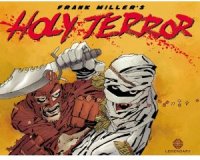
By Adam Prosser
How much leeway does irony get you? The answer to that question is pivotal to how you’ll react to Frank Miller’s Holy Terror, a self-styled work of “propaganda” that began life as a WWII-style story of Batman fighting terrorists filtered through Frank Miller’s…unique sensibilities, and has evolved into something almost indescribable. But I guess it’s my job to try and describe it, so here goes.
The Fixer is a street-level superhero working “Empire City, America”. He’s engaged in a pitched rooftop chase with an S & M-themed cat burglar named Natalie Stack (no alias that I could see) when a bomb, let off by a Muslim student, demolishes a downtown building. This launches a string of attacks, making it clear that Empire City is under siege by Al Qaeda. Natalie and the Fixer decide to put aside their differences to kick some terrorist ass and put a stop to an even bigger bombing planned for the end of the night.
It’s clear Miller’s been working on this for some time—the narrative pretty much acknowledges this with a string of insert panels that begin to appear at the halfway mark, showing various political figures and events in caricature (Bush, Cheney, and Michael Moore are the first to appear; Obama pops up at about the two-thirds mark.) Oddly, Miller doesn’t seem to have any specific commentary to make about these people, aside from a “sad trombone” drawing of Hillary Clinton that’s obviously supposed to represent her losing the Democratic nomination. No sign of Sarah Palin either (and Miller’s opinion on Palin is something I admit I would have liked to see) and I almost get the impression Miller doesn’t have any particular issue with Obama, though I’m probably wrong on that one. At any rate, this is a story that must have gotten started not too long after the invasion of Iraq and ends after the death of Bin Laden, the latter point of which clearly necessitated a last-minute change in the story’s archvillain. Miller made a specific point of the fact that the story would feature a “Captain America punches Hitler” moment with Bin Laden, but his real-world death puts the damper on that, so instead Miller swaps it out, rather breathtakingly, for the revelation that Bin Laden was “a slave beneath a slave beneath a slave” in a much larger conspiracy that at this point might as well involve alien replicants from beyond the moon.
And that’s fine as far as it goes; Miller’s taking his inspiration from WWII era comics, which regularly portrayed Nazis and Japanese as cartoonish supervillains with little or no basis in reality. I’m pretty sure no one picked up this book expecting the surface-level politics to be anything but neanderthaline and reactionary, regardless of how they personally feel, so there’s a certain sense of resignation while you’re reading it. The police department (including the Commissioner Gordon analogue) being secretly controlled by Muslim extremists? Sure, why not? The oldest mosque in Empire City being a staging ground for terrorism, and built on the ruins of an ancient civilization? OK, Frank! The Fixer almost gleefully deciding, about ten minutes after the first bomb goes off, that now he gets to torture people? Unusually honest! The Al Qaeda operatives (Miller mistranslates “Al Qaeda” as “the cell”, by the way) being unable to build a sophisticated bomb by themselves and requiring the intervention of a rogue IRA agent? Sigh.
Though I will admit that Miller chiding Muslims for being women-haters takes a level of brass that may surpass his putting homophobic sentiments in the mouths of Spartans.
The question is, how much of this is intended as tongue-in-cheek? Again, Miller’s pretty clearly framed all this as “propaganda”, but my problem here is twofold. One, there might have been some justification, back in the day, for inspiring people to fight the Nazis and Japanese via misleading appeals to America’s baser nature (though you’d think that the real-world atrocities of the Nazis would render the need for exaggeration moot), but I’d argue that time is long past, and the current conflict is too full of subtle distinctions and too rooted in the ideological sphere to see any real benefit from hamfisted depiction of monsters that need to be smashed. America’s not at war with Islam, a distinction that really needs to be made, and when Miller portrays it otherwise the story stops being about inspiring people and starts being about finding scapegoats to make him and his audience feel better.
Too, Miller’s been playing the “tongue-in-cheek” card for practically his whole career at this point, and the novelty has worn thin. It’s clear that this comic does reflect Miller’s beliefs to a certain extent, and it’s hard not to see the tissue of reflective irony as anything but an excuse for Miller’s excesses, just as it was for All-Star Batman and Robin, and 300, and Sin City.
Is there any way to separate the message from the context and judge Holy Terror as a comic? I don’t really think so, but inasmuch as I can, it’s not much of a success there either. Miller’s draftsmanship has been sliding drastically since 300 (possibly from lack of practice) and while he’s clearly trying a little harder here than he has in years, there are too many panels where it’s impossible to tell what’s going on, too many off-model figures, too many times where Miller’s usual penchant for stylization—once one of his greatest strengths—ends up looking just weird. There are flashes of Miller’s narrative and compositional genius; I liked parts of the opening chase in the rain, the caricatures are actually good, and there are some nice uses of silhouette. But for the most part this is an ugly book on every level, and you’d have to be either a real reactionary bonehead or some kind of uber-hipster to derive true entertainment from it.
Rating: 




Out of a Possible 5 Stars
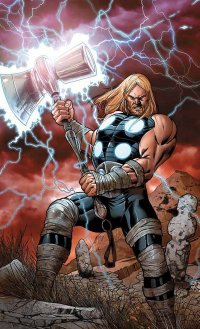 Ultimate Comics Thor tpb (Marvel, $15.99)
Ultimate Comics Thor tpb (Marvel, $15.99)
by Graig Kent
It’s been made fairly clear that the Marvel films that are leading into the Avengers movie are inspired as much by the “Ultimate” line as they are by any stories in the core Marvel Universe. But the “Ultimate” version of Thor, from what I can recall of my limited Ultimates reading, was intended to be a science-based hero, rather than a true Norse God, though there was always room left for doubt, and the possibility the character was a tad nuts. Back in late 2010, with the Thor blockbuster approaching (wherein he was indeed a Norse god and Asgard was a major setting), Ultimate Comics Thor was offered up as a slight retcon to the character and a bridge between the comics and the film.
Jonathan Hickman, now one of the “architects” of the Ultimate line, cut his teeth on trying to resolve what was already known about Ultimate Thor, while actually fitting in the Norse mythology in that universe. To no surprise for any follower of Hickman’s rather prolific and excellent output at Marvel, he makes it work. Instead of introducing Asgard into the present day of the Ultimate Universe, he flashes back to its (last minute Spoiler Alert) destruction. But it’s not about what happened, more how it happened, and how it affected Thor, planting the seeds for what has happened to the character since as well as what’s to come.
Carlos Pacheco is tasked with drawing numerous different settings and eras, from WWII sequences, to the exotic environments of Asgard to futuristic, high-tech government operations facilities, and he delivers. Pacheco’s character are distinctive, each individual crafted with a unique look, and his action sequences carry in equal measure drama and momentum.
I’m not a Thor fan. I can count on one hand the number of comics I’ve bought with his name in the title (in fact I probably spent more time with the character in one viewing the Thor movie than I have spent reading Thor comics in my lifetime). The character doesn’t much interest me and often bores me. But I liked this. It’s a strong, assertive story, differentiating itself drastically from the familiar Marvel Universe version of the character while still striving to retain whatever it is about the character that appeals to the masses. It has a few connective threads to the film, which will make it fairly accessible to new readers drawn in from the movie, so a job well done all around.
Rating: 




Out of a Possible 5 Stars
The Strange Talent of Luther Strode #1 of 6 (Image, $2.99)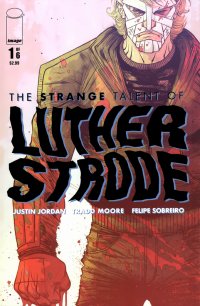
By Jeb D.
Generally, if I encounter a comic artist who knocks my socks off on first exposure, I find that they’ve already got a body of indie work, or some backup stories for the Big 2, in their portfolio. But so far as I can tell, artist Tradd Moore is new to this game, having hooked up with writer Justin Jordan via Deviant Art, and I gotta say, if this really is Moore’s actual “debut” as a comic artist, I’m impressed as hell.
The basic plot of The Strange Talent of Luther Strode is in the vein of Kick-Ass: Luther’s a bit of a high school geek (not so much in the sense of being wholly absorbed in the minutiae of pop culture, but mostly in the sense of being skinny and socially awkward). He lives with his mom, hangs with his buddy Pete, lusts after a hot redhead at school, and has decided to improve his prospects with the use of a Charles Atlas-type bodybuilding course. And judging from the book’s opening scene, it would seem that he succeeds to a degree he could never have imagined. The rest of the first issue is flashback to his great experiment, the abilities it’s given him, the repercussions (physical, romantic, and otherwise), and a peek at what appears to be a highly imposing foe. We also get hints that there’s more to Luther’s transformation than just running through the “Hercules” course exercises, possibly linked to a dark family background.
All well and good, and Jordan’s dialog and characterization are a bit more down-to-earth and believable than those of Kick-Ass, despite the obvious similarities. As I say, though, what really sets this apart is the amazing artwork. Moore has a slightly cartoony approach to character and faces: everyone’s fairly angular and a bit elongated, but within that, he varies both body shape and, in particular, facial expression, so that each member of the cast comes instantly to life. His paneling is fairly conventional, never flashy or showy for the sake of it, but his storytelling eye is superb: you could read a wordless copy of this issue and not really miss that much of what’s happening. The other characteristic of his work to note (and another link to Romita’s Kick-Ass): the man loves blood and gore, ripped limbs and vomited guts; much of what goes on in this issue reminds me of nothing so much as the sanguinary madness that Juan Jose Ryp employs at the behest of writers like Warren Ellis (and colorist Felipe Sobreiro gleefully joins in the fun). Not for the squeamish.
The nerd-becoming-superbeing isn’t exactly a new trope, but there’s still room to work with it, and the first issue of Luther Strode plants enough seeds of intrigue, and hints at enough secrets to come, that I’m on for the ride.
Rating: 




Out of a Possible 5 Stars
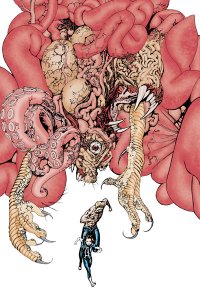 Animal Man #2 (DC Comics, $2.99)
Animal Man #2 (DC Comics, $2.99)
by Graig Kent
The last Animal Man ongoing series ran for 7 years and 88 issues, entering Vertigo territory on its 50th issue as one of the key instigators of the imprint. But most people only remember, or reference what Grant Morrison did in the first 26 issues, obviously setting the foundation for the Vertigo style alongside Sandman, Hellblazer, Doom Patrol and Shade: The Changing Man with highly meta-textual and outright out-there storytelling. Morrison made a character that was little-used in DC’s history into something not only relevant, but edgy and distinct, and it’s had a lasting impact.
That Animal Man was returning to his own title in “The New 52” was the subject of much speculation, and, to many, immediate dismissal. Writer Jeff Lemire was perhaps best known for his Essex County trilogy of interconnected stories in a farming community in Canada, although his Sweet Tooth ongoing series for Vertigo shifted perceptions of what he was capable of, but his Animal Man is poised to set him on a similar path to Morrison as arguably the biggest surprise, and perhaps biggest critical hit of the DC reboot.
The series is a logical extension of what Lemire was doing with Sweet Tooth and his pre-reboot work on Superboy, mixing elements of superheroism, family life, and horror in a Neapolitan swirl of tasty reading. The first issue set the groundwork perfectly, introducing Buddy Baker, his family, his day job as a stuntman (and burgeoning indie film lead actor) and his sideline gig as a superhero, and then slowly turning the screws thing things finally snapped on the final page. The second issue picks right up with Buddy’s daughter Maxine playing with her risen-from-the-dead pets, and Buddy and family sort of freaking out. The book follows through the domestic angle, sets forth into the “superhero” angle, and reconnecting with the supernatural/quasi-horrific elements as Buddy and Maxine must set out on a journey into “the red”, perhaps the source of all life.
Lemire understands what has been done before with Animal Man, from Morrison’s meta-foundation to Jamie Delano’s creepier explanation of Buddy’s powers, and he utilizes them and twists them to his own unique working. He’s honoring the character’s past without repeating it. Artist Travel Foreman has an exceptionally unique style, which often sees bodies and faces contorted in weird ways, as well his inking is a strange mix of thinly constructed lines, hard black shadows and feathery brushed shading, altogether making for a unusual-looking book, yet an absolutely perfect fit.
Rating: 




Out of a Possible 5 Stars
Avengers 1959 #1 0f 5 (Marvel, $2.99)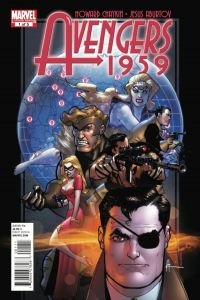
By Jeb D.
Well, here’s one you didn’t expect: a Howard Chaykin comic that (it would seem so far) is not driven by an undercurrent of U.S. government collusion with big business and mass-media exploitation. Mind you, it appears that the foe that the Mad Men-era superteam will be facing is one that’s nearly as played out as Chaykin’s beloved media-driven monsters, but as long as he keeps giving us issues as strong as this one, I’m not complaining. Yes, all his male characters share the same bulky body and blocky head shape, and would be indistinguishable if not for clothes and hairstyles, but the paces he puts them through, his instinctively imaginative paneling, his unique and distinctive approach to action, and his absolute commitment to the over-the-top storytelling possibilities of superheroes makes any Chaykin comic a joy to look at, and to follow. Note I don’t say “read”: his character and dialog work continue to lag behind his visual sense, and while that can often be compensated for by high concepts and the big picture, the jury’s still out on whether that will be the case here.
This first issue is a series of dangerous encounters for Nick Fury’s original post-WWII band of misfit “Avenger Initiative” operatives (Kraven, Sabertooth, Namora, Dominic Fortune, etc.) first introduced in the recent “Infinity” storyline, along with vintage “good girl” heroine The Blonde Phantom; we also get a tour of familiar Marvel hotspots like Latveria and Wakanda in their pre-FF #1 days. The period detail is fun, the visuals are sumptuously tasty, and for the most part, it’s all depicted in scenes of fighting, fleeing, and flying that are eye-poppingly entertaining. On the last page, we even get a hint of what might be Chaykin’s greatest meta-textual media in-joke yet.
It seems likely that the concept of the self-contained miniseries will eventually be the first permanent casualty of declining comics readership, since without the need to “keep up” with happenings in the rest of the Marvel U, a reader might as well wait for the trade version of a story like this. That said, this comic does an exceptional job of packing the first “set-up” issue of this mini with great colorful comic book fun.
Rating: 




Out of a Possible 5 Stars
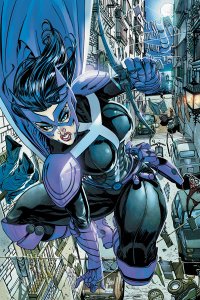 The Huntress #1 (of 6)(DC Comics, $2.99)
The Huntress #1 (of 6)(DC Comics, $2.99)
by Graig Kent
Last month, we were introduced to “The New 52”. This is the New 53rd.
If there was any character in the DC Comics stable that was primed for reinvention it would be the Huntress, in my opinion at least. Despite having read dozens upon dozens of stories with her over the past 25 years, the character had never clicked with me. Helena Bertinelli was a school teacher by day, and vigilante by night. She was the daughter of a mafia don, and made it her mission to clean the streets of organized crime (though with a keen focus on the Italian mafioso). There was perhaps the potential for something interesting there, but the mob stuff rarely came off as anything but recycled cliches, and outside of that, she had a lot of Catholic angst, something which is understandable considering how many crossbow arrows she could go through in an evening, and yet, even that character trait was never exploited to much great effect. Pre-Crisis, the Huntress was a much different, much simpler set-up: she was the daughter of Earth-2’s Catwoman and Batman.
The pre-Crisis Huntress was largely developed by writer Paul Levitz, who just happens to be the writer of this new reboot mini-series. What that means exactly, it’s not yet told as we don’t learn a great deal about this new Huntress’ background, but Levitz does deliver her character through her actions, her bad-ass actions. She’s strong, skilled, determined, ballsy, and somewhat unconcerned with her secret identity. But what that secret identity is, we’re not quite yet sure, as Levitz has concocted a foreign mission for Huntress to undertake, landing in Italy to hit some of her Gotham targets at their source, interrupting plans, and stumbling upon a human trafficking operation.
At this stage it’s a pretty bare-bones, almost all-action issue, forcing Huntress into an espionage-style role, which, I have to say, totally works for her. The story is good, but what propels it into solid entertainment is the art from Marcus To (inks by John Dell and colors from Andrew Dalhouse). I’m familiar with To’s work from the pre-reboot Red Robin series, where I grew into a solid admirer, but here he’s outdone himself. He’s pushed his action choreography to new heights, his detailing is phenomenal, his character designs and facial expressions are top notch and, as always, it’ some of the cleanest, tightest artwork you will see. This may be too small a character and too small a title to break him big, but he’s poised for superstardom. This is just a phenomenal book to look at.
It may be that DC is using this as an introduction to their planned “Earth 2” diversion with the forthcoming JSA series, or it may be just a 6-issue mob/espionage/action story, either way it’s off to a good start, and definitely worth coming back for more.
Rating: 




Out of a Possible 5 Stars
The Last of the Greats #1 of 6 (Image, $3.99)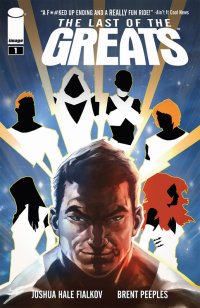
By Jeb D.
For their first half-century or so, superheroes were pretty much always on the obvious side of an unquestioned good guy-bad guy equation. Even when someone like Spider-Man wound up in trouble with the law, it was generally a case of the authorities simply assuming that he was on the wrong side of that equation, rather than questioning the equation’s validity in the first place; in other words, few of the cops chasing Spider-Man ever stopped to wonder whether a super-powered being of that type could ever truly be on “their side.” In that sense, J. Jonah Jameson turns out to be one of comics’ most prescient creations: while his motivations for hating Spidey shifted over the years—sometimes it was jealousy, sometimes resentment, sometimes fear, sometimes greed to sell papers– often it manifested as outright mistrust of society surrendering its social pregoratives and responsibilities to people in long underwear solving problems with their fists.
Of course, that fundamental question has been one of the key themes of superhero storytelling in the decades since, particularly outside the context of the monthly Big 2 offerings: books like Rising Stars, The Authority, Supreme Power, Irredeemable, etc. Last of the Greats is clearly of that lineage, and its first issue is competent, if not particularly distinguished.
On something resembling our Earth, a team of super-beings known as Greats arrived some years ago to steer us toward a better world. Despite their supposedly benevolent intentions,mankind eventually bridled at the notion of surrendering sovereignty over their lives (principally our weapons of defense), and revolted, killing all but one of their benefactors: the “last” of the Greats, who had refused to join his brethren in their bid to remake the human race, and who instead broods in an Antarctic Fortress of Solitude. In this issue, representatives of humanity come to make an appeal to him: an alien invasion is happening, and despite the fate of his fellow Greats, they plead with him to help against the invasion.
The bulk of the story consists of these principal characters engaged in debate as to whether or not that will, or should, happen. And while it’s easy to make the usual extrapolations about taking responsibility for ourselves, the age-old question of freedom versus security, etc., I don’t know that Last of the Greats adds anything to the discussion that we haven’t seen from its predecessors. Writer Joshua Hale Fialkov does throw in an unexpected twist at the end, but while it may be an effective plot device, it remains to be seen whether it will help lift the thematic elements above the usual. Artist Brent Peeples employs a clean, conventional style that looks like Big 2-style superhero work, and that might be part of what holds this comic back: when the story consists of this much talk, you want to see more of the internal life of the characters than Peeples allows their faces and body language reveal here (though if there are bigger action setpieces to come, he gives hints that he’ll be more than up to the task).
While virtually any miniseries probably reads better in collected form than single issues, Last of the Greats is one that I definitely suggest treadwaiting: by the time it’s done, there should be enough general buzz about it to let potential readers know whether or not it took off from its rather slow-paced opening chapter.
Rating: 




Out of a Possible 5 Stars
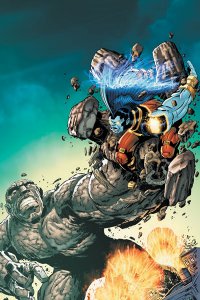 O.M.A.C. #2 (DC Comics, $2.99)
O.M.A.C. #2 (DC Comics, $2.99)
by Graig Kent
Of all “The New 52”, the rebooted O.M.A.C. series is easily the riskiest, considering the character’s history, or lack thereof. A minor (and phenomenally gaudy) Kirby creation from the 1970’s that lasted an entire 8 issues, and used sparingly thereafter, the OMAC concept was re-purposed a few years back as a key element of the Infinite Crisis event, but with only a few components of the original series left intact. This new series is born as a pet project of DC’s Co-Publisher Dan Didio and legendary writer-artist Keith Giffen, holding truer to Kirby’s original creation (while mixing in a plethora of other concepts like Checkmate and Cadmus and characters from across the DCU such as Max Lord, Mokkari, Dubbilex and Sarge Steel) but also not fully abandoning the more recent interpretation. Kevin Kho works for Cadmus but has unknowingly had his body hijacked by the sentient satellite in the sky, Brother Eye, and transformed into the One Man Army Corps as a tool for its own, as yet unknown machinations. Kevin is an unwilling participant, but, at the same time, recognizes that perhaps being O.M.A.C. can do some good, even if he’s not in control. The second issue, like the first, is a massive fight sequence wrapped in a loving tribute to Jack Kirby, with Giffen channeling the king on every page. It’s a visuals-first, story-and-character second kind of book (there’s a noted off-panel conversation between Kevin and the girlfriend introduced last issue, so obviously establishing that relationship’s dynamic isn’t that important), it’s all about the action and if a story sneaks its way in, all the better. It’s not as crazily off-beat as Kirby’s original (which is still pretty odd three decades later), which is too bad, since I think that surrealism might fare better with a modern audience. It’s not brilliant, but it is fun in an old school rock ’em sock ’em way.
Rating: 




Out of a Possible 5 Stars
New Avengers #16.5 (Marvel, $3.99)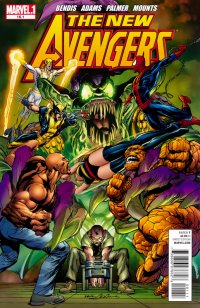
By Jeb D.
Look, I know everyone hates Bendis, and what he’s done with the Avengers; I won’t try and argue you out of that. But if Neal Adams’ recent comeback has been met with mixed results so far, this comic makes it seem as though he’s finally got his legs back under him again. In the time since he last worked for Marvel, the main cast of characters has shifted a bit, and this issue is basically one balls-out series of action beats featuring many characters for whom the Adams touch is not nostalgic, but actually fresh and new. Ms Marvel soars, Wolverine bleeds, Iron Fist and Jessica Jones go to town on armored flunkies, and Adams’ lanky, animated Norman Osborne hits that perfect blend of presentable madness that makes him appear more formidable than the bulky man-monster-in-a-suit way that we see too often; we also get a startlingly creepy Green Goblin reveal. And it ends with a moment of triumph for Osborne that seems like a good setup for the next few months of Avengers books.
Rating: 




Out of a Possible 5 Stars